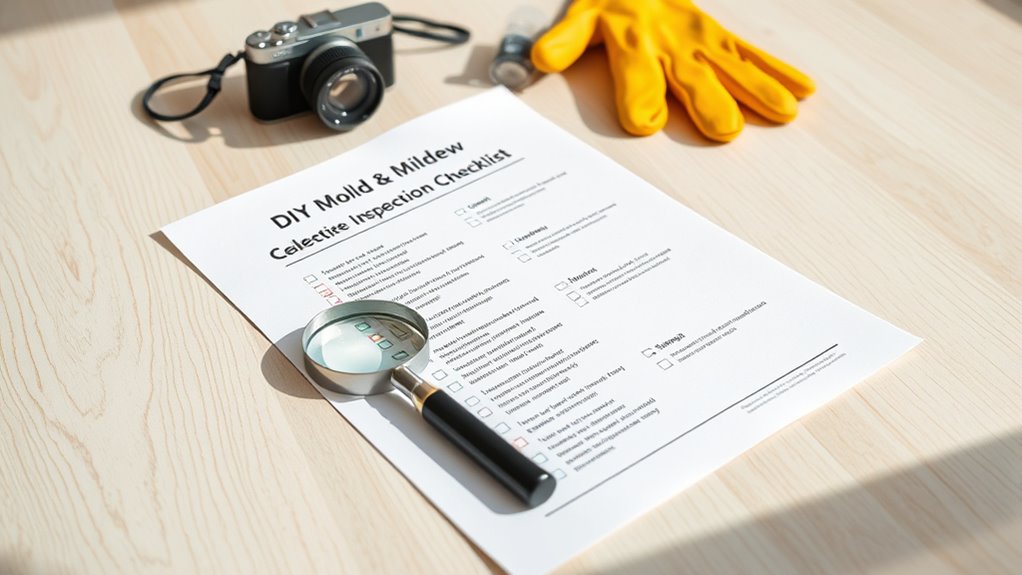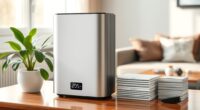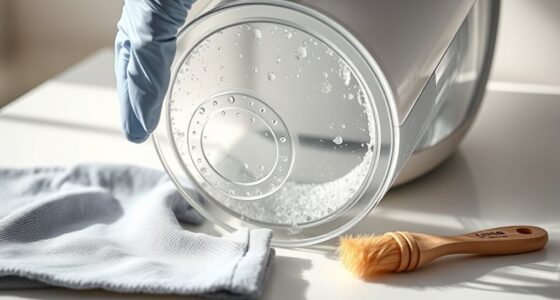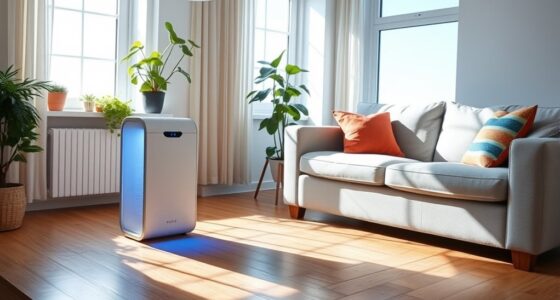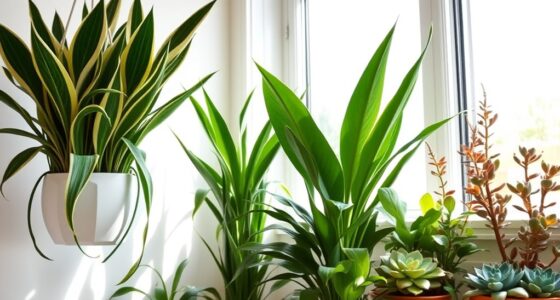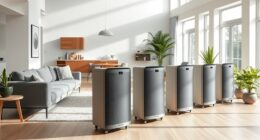To perform a DIY mold and mildew inspection, start by checking common risk areas like bathrooms, basements, and kitchens for visible signs such as discoloration, water stains, or a musty smell. Use tools like a flashlight, moisture meter, and camera to help spot hidden moisture or mold. Document your findings carefully. Maintaining good ventilation, fixing leaks promptly, and controlling humidity are key to prevention. Continuing will reveal detailed steps to help you keep your home safe and mold-free.
Key Takeaways
- Focus on high-risk areas like bathrooms, basements, and kitchens, checking for visible mold, moisture, and water stains.
- Use tools such as flashlights, moisture meters, and mold testing kits to identify hidden mold and dampness.
- Look for signs like discoloration, peeling paint, musty odors, and condensation on walls, ceilings, and around appliances.
- Inspect concealed spaces behind appliances, inside wall cavities, and beneath sinks for hidden mold and moisture buildup.
- Document findings with photos and notes, perform regular maintenance, and control indoor humidity to prevent mold growth.
Identify Common Areas Susceptible to Mold and Mildew
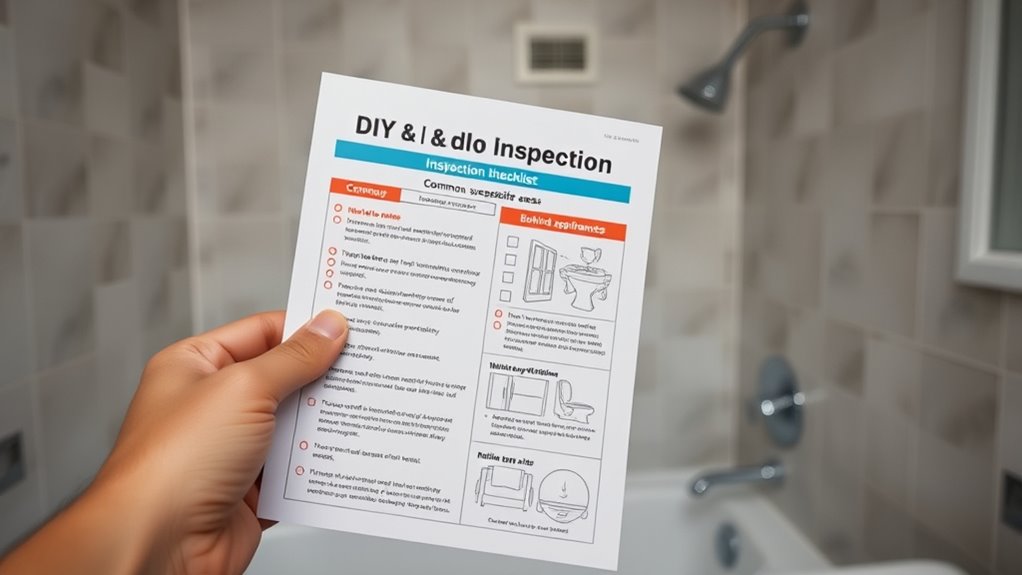
Some areas in your home are more prone to mold and mildew because they tend to stay damp or have poor ventilation. These mold-prone areas often include bathrooms, basements, laundry rooms, and kitchens, where moisture hotspots are common. Check around sinks, bathtubs, and showers for persistent dampness or water stains. Keep an eye on window sills and behind appliances that generate humidity. Poorly ventilated closets or crawl spaces can also trap moisture, creating ideal conditions for mold growth. Regularly inspect these areas for visible mold, a musty smell, or discoloration. Addressing moisture hotspots early helps prevent mold from spreading. Being aware of these common problem zones allows you to take proactive steps in your mold and mildew prevention efforts. Monitoring humidity levels can further help you maintain a dry environment and reduce mold risk.
Gather Essential Inspection Tools and Supplies

To effectively inspect your home for mold and mildew, you need the right tools and supplies on hand. Start with a flashlight to spot hidden mold in dark corners and behind appliances. A moisture meter helps identify areas with high humidity that encourage mold growth. Consider using mold testing kits for quick, preliminary air quality assessments. These kits can detect mold spores in the air or on surfaces, giving you a clearer picture of potential issues. Gloves and a mask are essential to protect yourself during inspection. A small mirror can help you see into tight spaces. Keep a notepad or camera to document problem areas. Having these tools ready guarantees a thorough inspection, helping you identify mold risks before they become serious. Additionally, understanding mold and mildew growth patterns can improve your inspection accuracy.
Conduct a Visual Inspection of Your Home’s High-Risk Zones
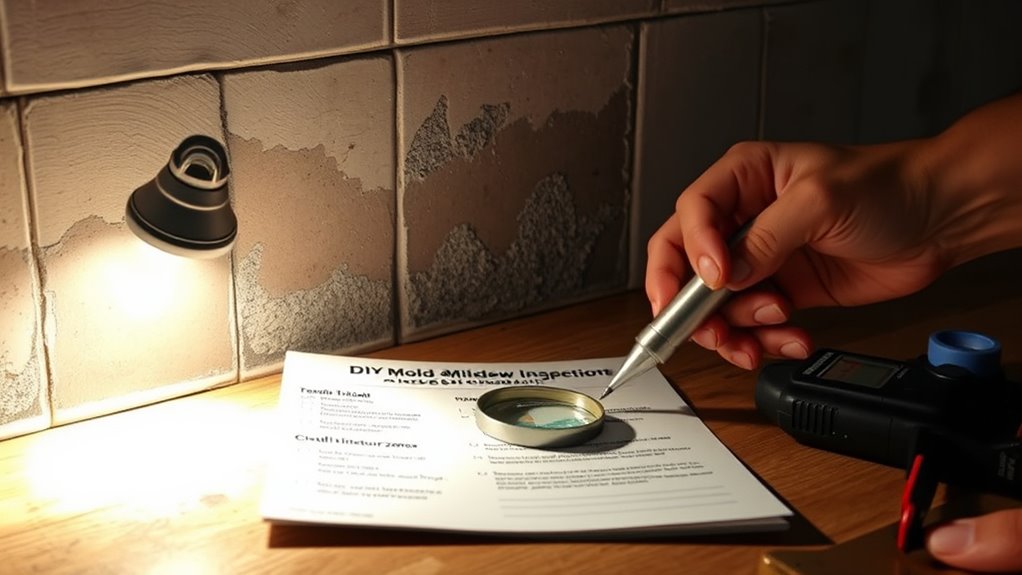
Start your inspection by carefully checking your kitchen and bathroom for signs of moisture or mold. Don’t forget to review the basement and attic, as these areas are common hiding spots. Finally, examine your windows and walls for any discoloration or water damage that could indicate mold growth. Be sure to also look for any water leaks or condensation issues that can contribute to mold development over time.
Check Kitchen & Bathroom
Your kitchen and bathroom are common hotspots for mold and mildew growth due to frequent moisture. Start by inspecting kitchen appliances like sinks, refrigerators, and dishwashers for signs of water leaks or mold buildup. Check bathroom fixtures such as sinks, toilets, and showers for discoloration, mold spots, or dampness. Look behind appliances and under sinks for hidden leaks or standing water. Pay attention to grout lines, caulking, and corners where moisture can accumulate unnoticed. Guarantee ventilation fans are working properly to reduce humidity. Any discoloration, musty odors, or visible mold indicate a need for cleaning and possibly further inspection. Regularly checking these high-risk zones helps catch problems early and keeps mold growth under control. Additionally, automation in building maintenance can help monitor humidity levels and detect leaks automatically, making ongoing inspections more efficient.
Review Basement & Attics
Ever wonder why basements and attics are prime spots for mold growth? These areas often have poor ventilation and high humidity, creating ideal conditions. When inspecting your basement and attic, focus on these key points:
- Check for signs of moisture or water stains on walls and ceilings.
- Ensure proper basement ventilation to promote airflow and reduce dampness.
- Inspect attic insulation for dampness, mold, or pests.
- Look for musty odors or visible mold patches, especially around vents and vents or near leaks.
- Regularly monitor air quality indicators to identify early signs of mold development and maintain a healthy environment.
Addressing ventilation issues in the basement and maintaining dry, well-insulated attics can prevent mold from taking hold. Regular visual inspections help catch problems early, saving you time and money.
Inspect Windows & Walls
Since windows and walls are common entry points for moisture and leaks, conducting a thorough visual inspection of these high-risk zones is essential. Look for signs of window condensation, which indicates excess humidity that can promote mold growth. Check around window frames for water stains, mold spots, or peeling paint. On walls, observe for wall paint peeling or bubbling, often caused by trapped moisture. Pay particular attention to areas near bathrooms, kitchens, or poorly ventilated spaces. Notice any discoloration, warping, or musty odors that could signal hidden mold. Addressing these issues early helps prevent mold from spreading. Regularly inspecting these high-risk zones ensures you catch problems before they escalate, keeping your home safe and mold-free. Additionally, understanding indoor air quality factors can help you identify other potential sources of mold and moisture problems.
Check for Signs of Moisture and Water Damage
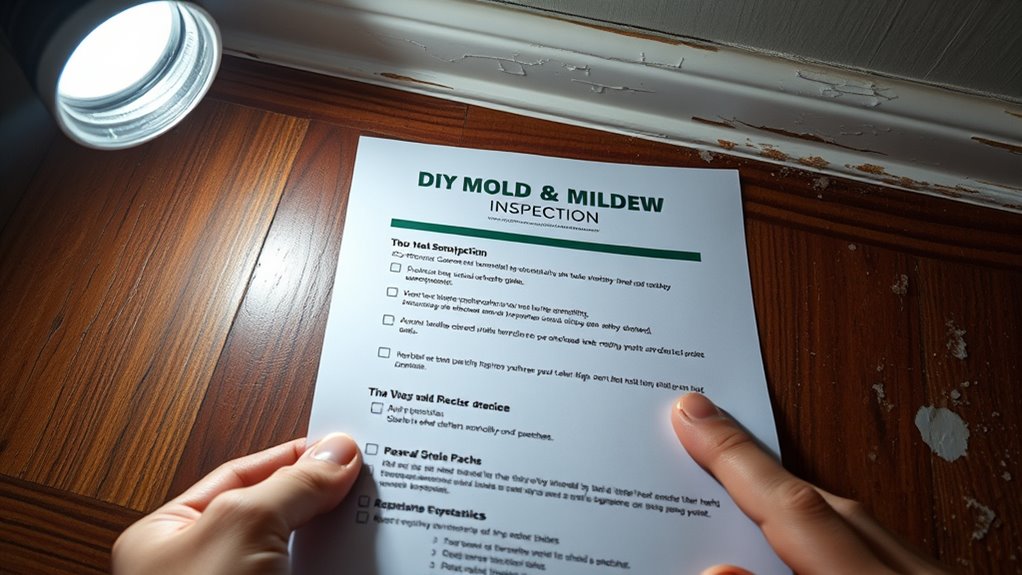
Moisture and water damage are often the first indicators of mold and mildew problems, so it’s essential to identify them early. Look for visible signs such as stains, discoloration, or peeling paint on walls and ceilings. Check for dampness or warping in floors and baseboards. Notice if there’s a persistent musty smell, which signals excess humidity. To prevent further issues, focus on improving air circulation and humidity control. Here are key steps to follow:
- Examine areas near windows and vents for condensation.
- Use a moisture meter to detect hidden dampness.
- Inspect plumbing fixtures for leaks or drips.
- Ensure proper ventilation in bathrooms and kitchens.
- Be aware that poor ventilation can contribute to increased moisture levels indoors.
Addressing these signs quickly helps minimize mold growth and maintains a healthier environment.
Inspect Hidden and Hard-to-Reach Spaces

To effectively detect hidden mold and mildew, you need to inspect those hard-to-reach spaces where moisture can hide undetected. These inaccessible areas often harbor mold growth because they’re out of sight and difficult to check. Focus on places like behind appliances, inside wall cavities, and beneath sinks. Use a flashlight and mirror to see into tight spots. Remember, mold can thrive in any area with persistent moisture. Here’s a quick reminder of common hidden spaces:
| Hidden Space | Inspection Tip | Potential Risk |
|---|---|---|
| Behind appliances | Move appliances away carefully | Moisture accumulation |
| Inside wall cavities | Check for discoloration or mold | Hidden growth |
| Beneath sinks | Look for leaks or water stains | Mold in inaccessible areas |
Additionally, understanding the art of home inspection can help you develop a thorough approach to identifying these issues early.
Document and Record Your Findings
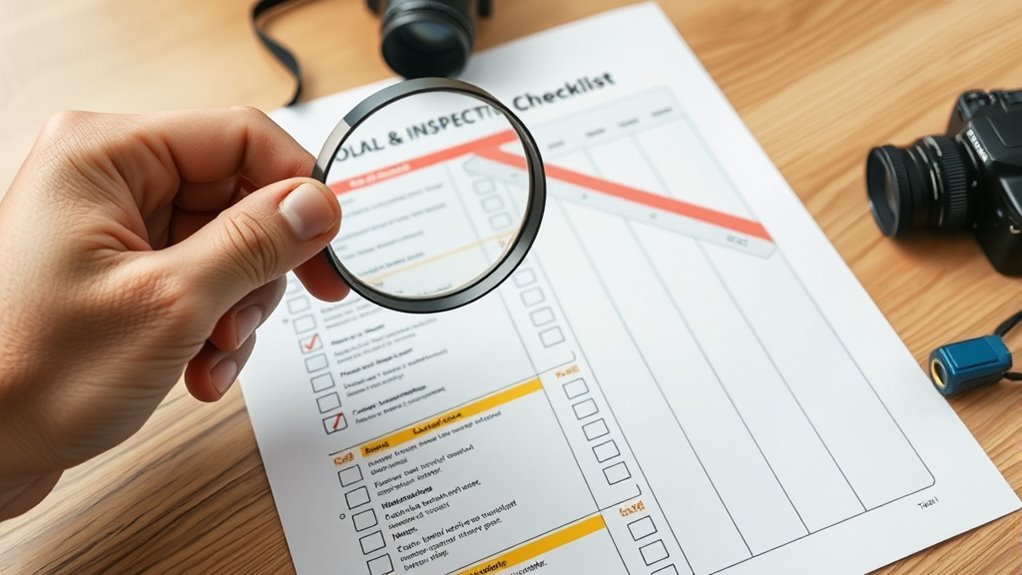
Keeping detailed records of your mold and mildew inspections is essential for tracking problem areas and monitoring progress over time. By documenting findings and recording evidence accurately, you guarantee consistency and clarity in your assessments. To do this effectively:
- Take clear photos of affected areas, noting the date and location.
- Write concise descriptions of mold or mildew appearance and extent.
- Log any odors or signs of water damage observed.
- Keep a checklist of areas inspected to avoid missing spots.
Regular maintenance and inspections can help prevent mold growth and catch issues early before they become more serious. This organized approach helps you identify recurring issues and provides valuable evidence if professional help becomes necessary. Consistent recording ensures you have a thorough history of your inspection efforts, making future decisions more informed and effective.
Develop a Maintenance and Prevention Plan
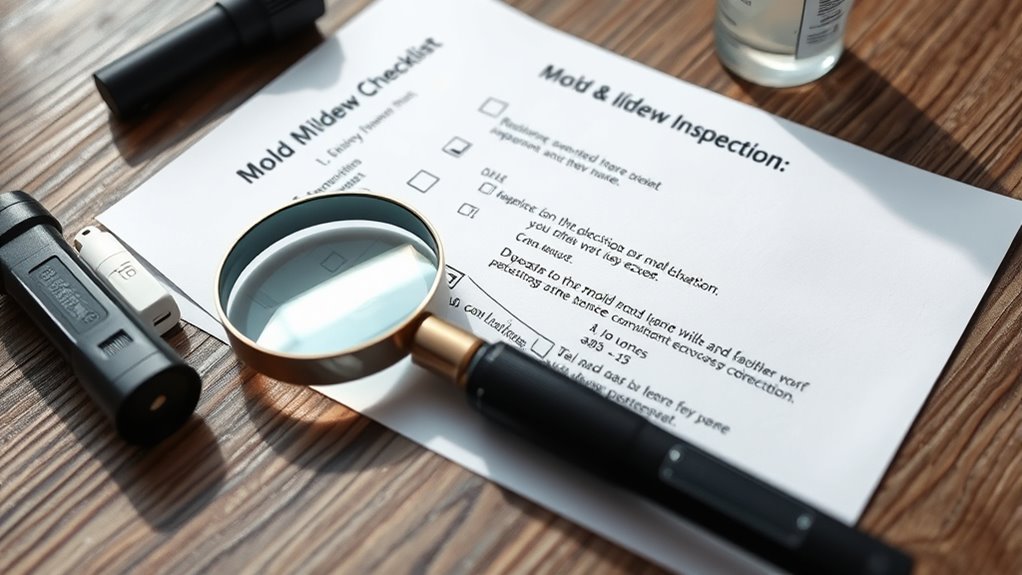
Creating a solid maintenance and prevention plan helps keep mold and mildew at bay. You should focus on implementing effective preventive measures and setting up a regular monitoring schedule. This way, you can catch problems early and keep your space healthier. Incorporating mindfulness and presence into your routine can also help you stay attentive to potential issues before they escalate.
Preventive Measures Effectively
Establishing a proactive maintenance and prevention plan is essential for effectively managing mold and mildew growth. To do this, focus on these key steps:
- Improve ventilation throughout your space to reduce humidity levels.
- Use mold-resistant materials in areas prone to moisture, like bathrooms and basements.
- Regularly inspect and repair leaks or water intrusion points promptly.
- Keep surfaces dry and clean with moisture-absorbing tools, such as dehumidifiers and exhaust fans.
- Choose appropriate paint sprayers designed for applying mold-resistant coatings to ensure thorough coverage and long-lasting protection.
Regular Monitoring Schedule
Implementing a regular monitoring schedule is essential for catching mold and mildew issues early before they become serious problems. Consistently check areas prone to moisture, like bathrooms, basements, and kitchens. Focus on humidity control by using dehumidifiers or vents to keep moisture levels below 60%, reducing mold growth potential. Ensure proper air circulation by opening windows, using exhaust fans, or installing fans to keep air moving, especially in enclosed spaces. Regular inspections help you identify any signs of mold or mildew early, allowing prompt action. Keep a log of your checks to track patterns and moisture levels over time. By maintaining this schedule, you actively prevent mold development and protect your home’s air quality.
Frequently Asked Questions
How Often Should I Perform DIY Mold Inspections at Home?
You should perform DIY mold inspections regularly to catch issues early. Aim for inspection frequency at least once a season, especially during seasonal checks when humidity and temperature fluctuate. Keep an eye on common problem areas like bathrooms, basements, and behind appliances. Regular inspections help you identify mold growth promptly, preventing costly repairs and health problems. Don’t forget to increase inspection frequency if you notice any musty odors or visible stains.
What Safety Precautions Should I Take During Mold Inspection?
Did you know that improper mold inspections can spread spores and worsen health issues? During your inspection, always wear personal protective equipment like gloves, masks, and goggles to protect yourself. Use good ventilation strategies to avoid inhaling mold spores and keep the area well-ventilated. Take breaks and avoid disturbing the mold excessively. Prioritize safety, and if mold seems extensive, consider consulting professionals for thorough removal.
Can I Identify Mold Without Professional Testing?
You can do some DIY detection by inspecting areas where you notice mold indicators like discoloration, musty odors, or water stains. Look for visible mold growth on walls, ceilings, and hidden spots like behind furniture. Keep in mind, though, that some mold may be hidden or grown in small quantities, making professional testing essential for accurate results. Use your senses and visual cues to identify potential mold issues early.
What Are Effective Cleaning Methods for Mold Remediation?
You’re really on the ball when it comes to mold removal. To effectively clean mold, use proven cleaning techniques like scrubbing with a mixture of water and detergent, then disinfect with a solution of bleach and water. Always wear protective gear. These cleaning techniques help eliminate mold and prevent its return. Remember, a stitch in time saves nine—address mold issues promptly for a healthier space.
How Do I Distinguish Between Mold and Harmless Stains?
When telling mold apart from harmless stains, look at mold color and stain texture. Mold often appears as fuzzy or slimy patches in shades like green, black, or white, and feels soft or spongy. Harmless stains usually have a flat, smooth texture and stay consistent in color. If you’re unsure, it’s best to test or consult a professional, since mold can pose health risks.
Conclusion
Now that you’ve completed your inspection, the real challenge begins. Will you catch every hidden mold threat before it spreads? Your careful documentation and proactive steps are essential, but some issues might still lurk out of sight. Stay vigilant and prepared to act quickly if you spot any warning signs. Remember, the next surprise mold problem could be just around the corner—are you ready to tackle it head-on?
